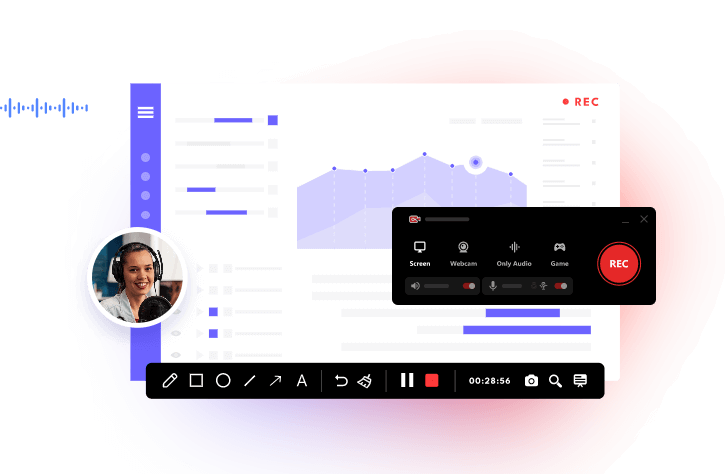HDMI is the primary channel for transmitting high-quality audio and video between devices. Whether to capture gameplay footage, preserve memorable moments from streaming services, or other needs, recording HDMI output to PC can be the main way for us.
This article will dive into the step-by-step instructions on how to record HDMI output to a PC. It lets you easily record videos from PlayStation, TV and other devices to your computer. Let’s get started.

Why Need to Record HDMI
There are several reasons why users may need to record HDMI output. One common reason is for content creation purposes. Content creators, such as YouTubers, gamers, and educators, may want to record their gameplay, tutorials, or presentations in high-definition quality. To record HDMI output to PC allows them to capture audio and video, enhancing the overall viewing experience for their audience.
Another reason users may need to record HDMI output to PC is for archiving purposes. Users may want to save important presentations, meetings, or events for future reference. By recording HDMI output, users can create digital copies of these valuable moments, ensuring they are never lost or forgotten.
Also read: How to Record on Roku in the Most Cost-Effective and Free Ways >>
Compatible Devices to Capture HDMI Video
With just HDMI, you can capture HDMI video from multiple devices to your computer. Below are the devices that you can use to record video from HDMI to PC.
TVs: Users can record their favorite TV shows, movies, or live events by connecting their television to a PC via HDMI.
Gaming Consoles: Gamers can capture their gameplay footage by connecting their gaming console to a PC using HDMI.
Cameras and Camcorders: Users can record HDMI video and photo from their cameras or camcorders by connecting them to a PC via HDMI.
Laptops and Computers: Users can mirror their laptop or computer screen to a PC using HDMI, allowing them to record presentations, tutorials, or any other content displayed on their screen.

How to Record HDMI Output to PC Step by Step
Recording HDMI output to a PC may seem like a daunting task, but with the right tools and specific steps, it can be a straightforward process. Here are the step-by-step instructions on how to record video from HDMI to PC.
Step 1: Gather the Necessary Equipment
- HDMI cable
- HDMI capture card or USB capture device
- PC with HDMI input capabilities
- Screen Recorder software
Step 2: Connect the HDMI Source to the Capture Device
Use an HDMI cable to connect the HDMI output of your source device (e.g., gaming console, TV) to the HDMI input of the capture device.
Step 3: Connect the Capture Device to Your PC
Connect the capture device to your PC using a USB cable (if applicable).
Step 4: Configure and Start Recording
- Once everything is set up, start recording with a screen recorder. The best one to record HDMI can be iTop Screen Recorder.
- Play the content or video on your HDMI source device.
- Ensure that the capture device is recognized and selected as the video source.
- Download and install iTop Screen Recorder on your PC, open it.
- Set the screen recording area and turn on speaker, you can set to record part of screen. Then click REC to start recording.

- Monitor the screen recording, once finished, click red square button to stop recording HDMI. You can check the recording, and make further editing with iTop built-in video editor.

In addition to record HDMI video, iTop Screen Recorder empowers you to screen record protected videos and more recording tasks. You can learn what iTop Screen Recorder can bring to you:
- Free to record video more than HDMI: This 1080P screen recorder can record live TV, record on Firestick, record video conferences, and also record audio only.
- Capture HDMI video at scheduled time: You can set the time for recording HDMI (including start and end time) according to your needs. Free your hands.
- Save recorded videos permanently: Use iTop Screen Recorder to record HDMI output to PC, and the computer can save your videos permanently. You can keep your recordings for as long as you like.
- Easy to use and versatile: With a simple recording interface, even beginners can use this screen recorder Windows 10 easily record screen, video, audio, and even webcam.
- Built-in video editor: In addition, iTop Screen Recorder is also a free video editor for you to edit your recordings.
Record HDMI Video – Common Issues
There are some common problems you may encounter when you record HDMI video:
Audio or video lag: This can occur due to a slow internet connection or insufficient processing power on your PC.
HDCP (High-bandwidth Digital Content Protection) errors: Some HDMI sources may have HDCP protection, which can prevent recording. In such cases, you need to use a HDMI splitter or HDCP bypass device.
Audio/video synchronization issues: This can occur if there is a delay between the audio and video signals. You can adjust the settings in your screen recording software to correct this issue.
The Bottom Line
This ultimate guide makes it easy for you to record HDMI. By following the steps outlined in this article and taking the necessary precautions, you can successfully capture high-quality audio and video from HDMI source devices. Whether you are capturing gaming highlights, preserving precious memories, or enhancing professional presentations, you can record HDMI to bring the vision to life with ease and precision. Remember to choose a suitable HDMI cable, capture card, and try the best screen recorder iTop Screen Recorder to record HDMI output to PC without effort.
 Vidnoz AI creates engaging videos with realistic AI avatars. Free, fast and easy-to-use.
Vidnoz AI creates engaging videos with realistic AI avatars. Free, fast and easy-to-use.














